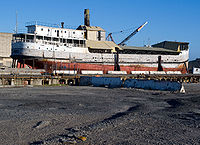.gif)
Wapama (steam schooner)
Encyclopedia
Wapama, also known as Tongass, is a vessel now located in Richmond, California
. She is the last surviving example of some 225 wooden steam schooners that served the lumber trade
and other coastal services along the Pacific Coast of the United States
She is managed by the National Park Service
at San Francisco Maritime National Historical Park
, but is currently located across the bay
awaiting possible renovation.
Wapama was declared a National Historic Landmark
in 1984.
Currently, she has severe dry rot which has threatened the structural integrity of the hull. The National Maritime Museum plans to dismantle it.
The Wapamas impending doom follows the fate of the lumber schooner Wawona (1897) of the Northwest Seaport, Seattle, Washington, which was broken up in 2009.
Not all listed historic wooden ships considered in need of major restoration in recent years have ended up being broken up. The lumber schooner C A Thayer (1895), also a NPS charge, was restored, although 80% of her wood was replaced through a restoration that lasted from 2004 to 2007. Mystic Seaport began a major restoration of the whaler Charles W Morgan (1841) in 2009 to seaworthy status.

Richmond, California
Richmond is a city in western Contra Costa County, California, United States. The city was incorporated on August 7, 1905. It is located in the East Bay, part of the San Francisco Bay Area. It is a residential inner suburb of San Francisco, as well as the site of heavy industry, which has been...
. She is the last surviving example of some 225 wooden steam schooners that served the lumber trade
West coast lumber trade
The West Coast lumber trade was a maritime trade route on the West Coast of the United States. It carried lumber from the coasts of Washington, Oregon, and Northern and Central California mainly to the port of San Francisco.-Lumber schooners:...
and other coastal services along the Pacific Coast of the United States
United States
The United States of America is a federal constitutional republic comprising fifty states and a federal district...
She is managed by the National Park Service
National Park Service
The National Park Service is the U.S. federal agency that manages all national parks, many national monuments, and other conservation and historical properties with various title designations...
at San Francisco Maritime National Historical Park
San Francisco Maritime National Historical Park
The San Francisco Maritime National Historical Park is located in San Francisco, California, USA. The park includes a fleet of historic vessels, a visitor center, a maritime museum, and a library/research facility...
, but is currently located across the bay
San Francisco Bay
San Francisco Bay is a shallow, productive estuary through which water draining from approximately forty percent of California, flowing in the Sacramento and San Joaquin rivers from the Sierra Nevada mountains, enters the Pacific Ocean...
awaiting possible renovation.
Wapama was declared a National Historic Landmark
National Historic Landmark
A National Historic Landmark is a building, site, structure, object, or district, that is officially recognized by the United States government for its historical significance...
in 1984.
Description
She is a wooden schooner of 204 feet (62.2 m), 40 feet (12.2 m) across with 2 masts. She has a triple-expansion steam engine with 825 hp. She could carry 1000000 board feet (2,359.7 m³) of lumber.Currently, she has severe dry rot which has threatened the structural integrity of the hull. The National Maritime Museum plans to dismantle it.
Update
The National Parks Service has announced its intention to dismantle the Wapama in a May 19, 2011, San Francisco Chronicle article, but it also has considered saving the steam engine. While a majority of bloggers responding to the article voiced dismay and/or support for preservation, a minority advocated burning the Wapama in a manner done to the last commercial Great Lakes sailing ship J T Wing at Belle Isle near the site of the present day Dossin Great Lakes Museum, Detroit, Mi.The Wapamas impending doom follows the fate of the lumber schooner Wawona (1897) of the Northwest Seaport, Seattle, Washington, which was broken up in 2009.
Not all listed historic wooden ships considered in need of major restoration in recent years have ended up being broken up. The lumber schooner C A Thayer (1895), also a NPS charge, was restored, although 80% of her wood was replaced through a restoration that lasted from 2004 to 2007. Mystic Seaport began a major restoration of the whaler Charles W Morgan (1841) in 2009 to seaworthy status.
Other surviving wooden American steamers
Five other American wood steamboats survive, although three are much smaller than the Wapama. They are the Virginia V (1922) of Seattle; the Sabino (1908), a former Maine boat now operated by Mystic Seaport of Connecticut; the Minnehaha (1906), of Lake Minnetonka, Wisconsin; the Nenana (1933), an Alaskan stern-wheeler; and the railroad ferry Ukiah/Eureka (1890) a museum ship in San Francisco. The first three are screw steamers. The Steamer Virginia V Foundation undertook a $6.5-million stem-to-stern restoration of their charge, which lasted from 1995 to 2001.

